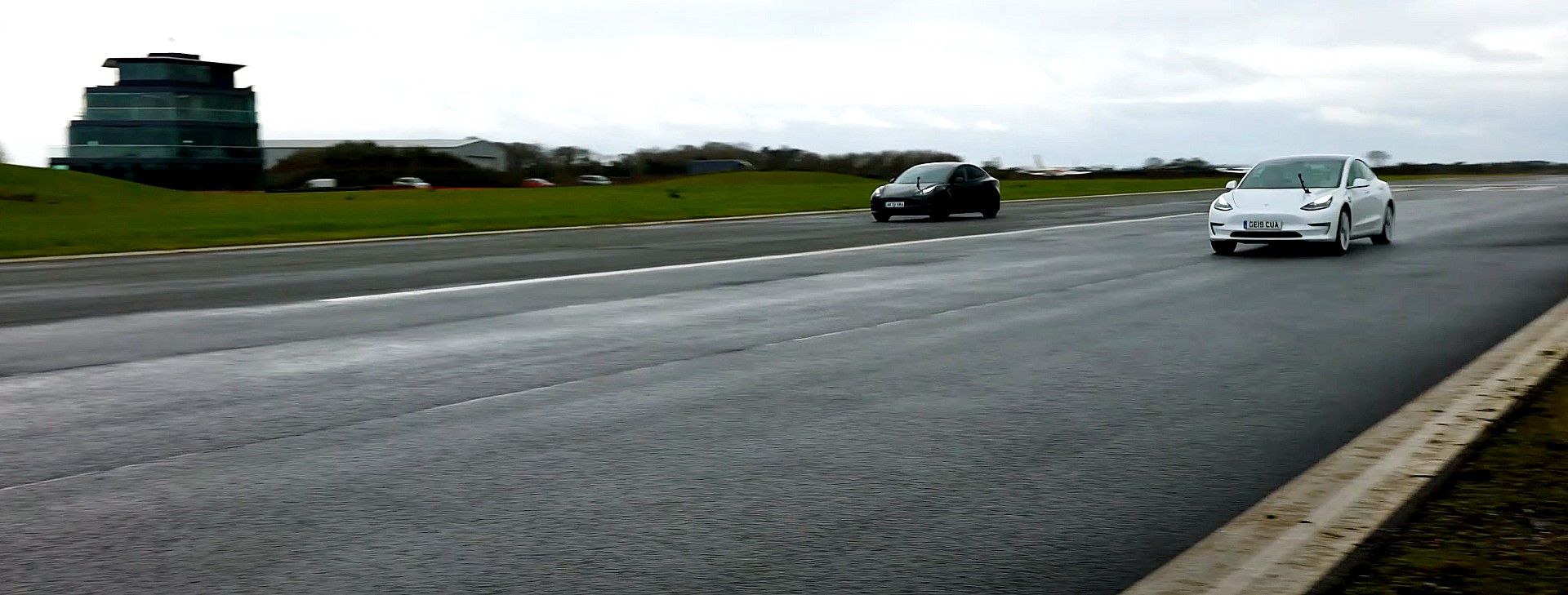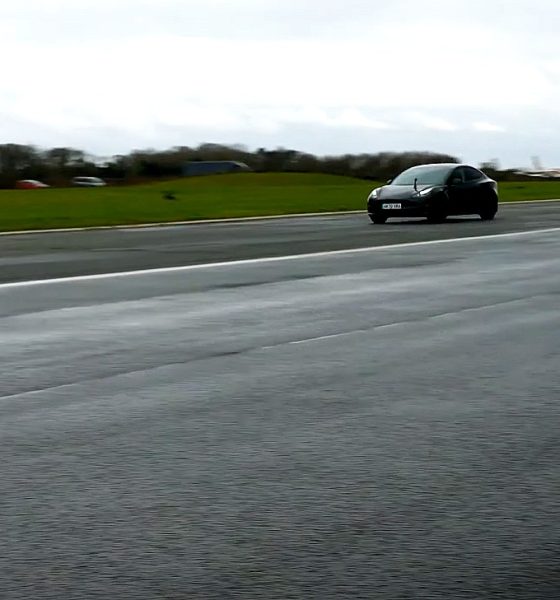

News
2021 Tesla Model 3 Performance gives way to the 2020 version of itself in drag race
The Tesla Model 3 has been on the market since 2017, and in typical Tesla fashion, the automaker has made several changes to the car over this period. Tesla’s updates span across all of its vehicles. Frequently referred to as “refreshes,” Tesla often updates cosmetic details and attempts to improve overall vehicle performance, whether it would be through speed and acceleration or through improvements to battery longevity and range. Carwow, a U.K.-based automotive platform, wanted to find out if the new Model 3 Performance could outduel an old Model 3 Performance on the drag strip, and the results were interesting, to say the least.
Both vehicles equip Tesla’s Dual Motor setup that comes standard with all of its Performance variants. Both Model 3s pack 457 horsepower, 660 Newton-meters of torque, and both vehicles weight is nearly identical. The old Model 3 weighs just three kilograms more at 1,847 kg, while the new Model 3 “steps” on the scale at only 1,844 kg. The wheels used on the newer Model 3 Performance are the 20″ Überturbine edition, which Carwow says are a kilogram heavier than the previously used 20″ Model 3 Sport Wheels.
The biggest changes are present in the battery pack. The previous version of the vehicle packed a 75 kWh battery pack, while new builds come with an 82 kWh pack. Other minor contributors to weight discrepancies between the two vehicles can be attributed to things as minor as the double-paned glass that Tesla included in several new cars to combat excessive cabin noise. Both vehicles operated in the “Sport” acceleration mode, the “Standard” steering mode, and regenerative braking was put on the “Standard” setting. Neither car operated in Tesla’s Track Mode.
During the two initial runs, the vehicles started from a standstill. The “old” Model 3, which was manufactured in 2020, managed to beat the new 2021 Model 3 in a race to the finish line. It wasn’t overly decisive, however, and both cars completed the 1/4-mile race in 11.7 seconds. During races where the two vehicles were at a rolling pace of 30 MPH, the two vehicles remained virtually identical, although the 2021 Model 3 crossed the finish line before its 2020 sibling.
Another rolling start race, this time at 50 MPH, proved to yield the same results. While the two vehicles seemed to travel at a nearly identical pace, the 2021 Model 3 once again crossed the finish line as a victor.
Carwow also performed a braking test, but the results were inconclusive as the track conditions seemed to affect the results during numerous test runs.
While the performance hasn’t seemed to change much between the two vehicles, it certainly appears that the race was almost too close to determine whether either of the Model 3 builds is superior to the other. Nevertheless, the race proved one thing in particular: the Model 3 is a fast, fun, and affordable EV with some of the best performance on the market for a midsized sedan. Its numerous crash safety awards and its nomination as one of the NTHSA’s Top Safety Pick+ recipients also attest to Tesla’s focus on consumer safety.
Check out the Carwow drag race below, and let us know what you think in the comments!

News
Tesla FSD fleet is nearing 7 billion total miles, including 2.5 billion city miles
As can be seen on Tesla’s official FSD webpage, vehicles equipped with the system have now navigated over 6.99 billion miles.

Tesla’s Full Self-Driving (Supervised) fleet is closing in on almost 7 billion total miles driven, as per data posted by the company on its official FSD webpage.
These figures hint at the massive scale of data fueling Tesla’s rapid FSD improvements, which have been quite notable as of late.
FSD mileage milestones
As can be seen on Tesla’s official FSD webpage, vehicles equipped with the system have now navigated over 6.99 billion miles. Tesla owner and avid FSD tester Whole Mars Catalog also shared a screenshot indicating that from the nearly 7 billion miles traveled by the FSD fleet, more than 2.5 billion miles were driven inside cities.
City miles are particularly valuable for complex urban scenarios like unprotected turns, pedestrian interactions, and traffic lights. This is also the difference-maker for FSD, as only complex solutions, such as Waymo’s self-driving taxis, operate similarly on inner-city streets. And even then, incidents such as the San Francisco blackouts have proven challenging for sensor-rich vehicles like Waymos.
Tesla’s data edge
Tesla has a number of advantages in the autonomous vehicle sector, one of which is the size of its fleet and the number of vehicles training FSD on real-world roads. Tesla’s nearly 7 billion FSD miles then allow the company to roll out updates that make its vehicles behave like they are being driven by experienced drivers, even if they are operating on their own.
So notable are Tesla’s improvements to FSD that NVIDIA Director of Robotics Jim Fan, after experiencing FSD v14, noted that the system is the first AI that passes what he described as a “Physical Turing Test.”
“Despite knowing exactly how robot learning works, I still find it magical watching the steering wheel turn by itself. First it feels surreal, next it becomes routine. Then, like the smartphone, taking it away actively hurts. This is how humanity gets rewired and glued to god-like technologies,” Fan wrote in a post on X.
News
Tesla starts showing how FSD will change lives in Europe
Local officials tested the system on narrow country roads and were impressed by FSD’s smooth, human-like driving, with some calling the service a game-changer for everyday life in areas that are far from urban centers.

Tesla has launched Europe’s first public shuttle service using Full Self-Driving (Supervised) in the rural Eifelkreis Bitburg-Prüm region of Germany, demonstrating how the technology can restore independence and mobility for people who struggle with limited transport options.
Local officials tested the system on narrow country roads and were impressed by FSD’s smooth, human-like driving, with some calling the service a game-changer for everyday life in areas that are far from urban centers.
Officials see real impact on rural residents
Arzfeld Mayor Johannes Kuhl and District Administrator Andreas Kruppert personally tested the Tesla shuttle service. This allowed them to see just how well FSD navigated winding lanes and rural roads confidently. Kruppert said, “Autonomous driving sounds like science fiction to many, but we simply see here that it works totally well in rural regions too.” Kuhl, for his part, also noted that FSD “feels like a very experienced driver.”
The pilot complements the area’s “Citizen Bus” program, which provides on-demand rides for elderly residents who can no longer drive themselves. Tesla Europe shared a video of a demonstration of the service, highlighting how FSD gives people their freedom back, even in places where public transport is not as prevalent.
What the Ministry for Economic Affairs and Transport says
Rhineland-Palatinate’s Minister Daniela Schmitt supported the project, praising the collaboration that made this “first of its kind in Europe” possible. As per the ministry, the rural rollout for the service shows FSD’s potential beyond major cities, and it delivers tangible benefits like grocery runs, doctor visits, and social connections for isolated residents.
“Reliable and flexible mobility is especially vital in rural areas. With the launch of a shuttle service using self-driving vehicles (FSD supervised) by Tesla in the Eifelkreis Bitburg-Prüm, an innovative pilot project is now getting underway that complements local community bus services. It is the first project of its kind in Europe.
“The result is a real gain for rural mobility: greater accessibility, more flexibility and tangible benefits for everyday life. A strong signal for innovation, cooperation and future-oriented mobility beyond urban centers,” the ministry wrote in a LinkedIn post.
News
Tesla China quietly posts Robotaxi-related job listing
Tesla China is currently seeking a Low Voltage Electrical Engineer to work on circuit board design for the company’s autonomous vehicles.

Tesla has posted a new job listing in Shanghai explicitly tied to its Robotaxi program, fueling speculation that the company is preparing to launch its dedicated autonomous ride-hailing service in China.
As noted in the listing, Tesla China is currently seeking a Low Voltage Electrical Engineer to work on circuit board design for the company’s autonomous vehicles.
Robotaxi-specific role
The listing, which was shared on social media platform X by industry watcher @tslaming, suggested that Tesla China is looking to fill the role urgently. The job listing itself specifically mentions that the person hired for the role will be working on the Low Voltage Hardware team, which would design the circuit boards that would serve as the nervous system of the Robotaxi.
Key tasks for the role, as indicated in the job listing, include collaboration with PCB layout, firmware, mechanical, program management, and validation teams, among other responsibilities. The role is based in Shanghai.
China Robotaxi launch
China represents a massive potential market for robotaxis, with its dense urban centers and supportive policies in select cities. Tesla has limited permission to roll out FSD in the country, though despite this, its vehicles have been hailed as among the best in the market when it comes to autonomous features. So far, at least, it appears that China supports Tesla’s FSD and Robotaxi rollout.
This was hinted at in November, when Tesla brought the Cybercab to the 8th China International Import Expo (CIIE) in Shanghai, marking the first time that the autonomous two-seater was brought to the Asia-Pacific region. The vehicle, despite not having a release date in China, received a significant amount of interest among the event’s attendees.








